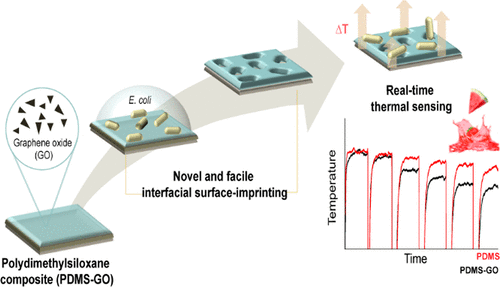Our official English website, www.x-mol.net, welcomes your feedback! (Note: you will need to create a separate account there.)
Imprinted Polydimethylsiloxane-Graphene Oxide Composite Receptor for the Biomimetic Thermal Sensing of Escherichia coli
ACS Sensors ( IF 8.9 ) Pub Date : 2022-05-10 , DOI: 10.1021/acssensors.2c00215 Rocio Arreguin-Campos 1 , Kasper Eersels 1 , Renato Rogosic 1 , Thomas J Cleij 1 , Hanne Diliën 1 , Bart van Grinsven 1
ACS Sensors ( IF 8.9 ) Pub Date : 2022-05-10 , DOI: 10.1021/acssensors.2c00215 Rocio Arreguin-Campos 1 , Kasper Eersels 1 , Renato Rogosic 1 , Thomas J Cleij 1 , Hanne Diliën 1 , Bart van Grinsven 1
Affiliation

|
This work presents an imprinted polymer-based thermal biomimetic sensor for the detection of Escherichia coli. A novel and facile bacteria imprinting protocol for polydimethylsiloxane (PDMS) films was investigated, and these receptor layers were functionalized with graphene oxide (GO) in order to improve the overall sensitivity of the sensor. Upon the recognition and binding of the target to the densely imprinted polymers, a concentration-dependent measurable change in temperature was observed. The limit of detection attained for the sensor employing PDMS-GO imprints was 80 ± 10 CFU/mL, a full order lower than neat PDMS imprints (670 ± 140 CFU/mL), illustrating the beneficial effect of the dopant on the thermo-dynamical properties of the interfacial layer. A parallel benchmarking of the thermal sensor with a commercial impedance analyzer was performed in order to prove the possibility of using the developed PDMS-GO receptors with multiple readout platforms. Moreover, S. aureus, C. sakazakii and an additional E. coli strain were employed as analogue species for the assessment of the selectivity of the device. Finally, because of the potential that this biomimetic platform possesses as a low-cost, rapid, and on-site tool for monitoring E. coli contamination in food safety applications, spiked fruit juice was analyzed as a real sample. Reproducible and sensitive results fulfill the limit requirements of the applicable European microbiological regulation.
中文翻译:

用于大肠杆菌仿生热传感的印迹聚二甲基硅氧烷-氧化石墨烯复合受体
这项工作提出了一种基于印迹聚合物的热仿生传感器,用于检测大肠杆菌. 研究了一种用于聚二甲基硅氧烷 (PDMS) 薄膜的新型、简便的细菌印迹方案,并用氧化石墨烯 (GO) 对这些受体层进行了功能化,以提高传感器的整体灵敏度。在目标识别并结合到致密印记的聚合物上后,观察到浓度依赖性可测量的温度变化。使用 PDMS-GO 印记的传感器获得的检测限为 80 ± 10 CFU/mL,比纯 PDMS 印记 (670 ± 140 CFU/mL) 低一个完整的数量级,说明掺杂剂对热力学的有益影响界面层的性质。使用商业阻抗分析仪对热传感器进行并行基准测试,以证明将开发的 PDMS-GO 受体与多个读出平台一起使用的可能性。而且,S. aureus、C. sakazakii和另一种大肠杆菌菌株被用作类似物,用于评估装置的选择性。最后,由于该仿生平台具有作为用于监测食品安全应用中大肠杆菌污染的低成本、快速和现场工具的潜力,因此将加标果汁作为真实样品进行分析。可重现和敏感的结果满足适用的欧洲微生物法规的限制要求。
更新日期:2022-05-10
中文翻译:

用于大肠杆菌仿生热传感的印迹聚二甲基硅氧烷-氧化石墨烯复合受体
这项工作提出了一种基于印迹聚合物的热仿生传感器,用于检测大肠杆菌. 研究了一种用于聚二甲基硅氧烷 (PDMS) 薄膜的新型、简便的细菌印迹方案,并用氧化石墨烯 (GO) 对这些受体层进行了功能化,以提高传感器的整体灵敏度。在目标识别并结合到致密印记的聚合物上后,观察到浓度依赖性可测量的温度变化。使用 PDMS-GO 印记的传感器获得的检测限为 80 ± 10 CFU/mL,比纯 PDMS 印记 (670 ± 140 CFU/mL) 低一个完整的数量级,说明掺杂剂对热力学的有益影响界面层的性质。使用商业阻抗分析仪对热传感器进行并行基准测试,以证明将开发的 PDMS-GO 受体与多个读出平台一起使用的可能性。而且,S. aureus、C. sakazakii和另一种大肠杆菌菌株被用作类似物,用于评估装置的选择性。最后,由于该仿生平台具有作为用于监测食品安全应用中大肠杆菌污染的低成本、快速和现场工具的潜力,因此将加标果汁作为真实样品进行分析。可重现和敏感的结果满足适用的欧洲微生物法规的限制要求。



























 京公网安备 11010802027423号
京公网安备 11010802027423号